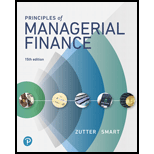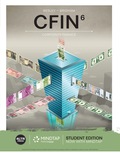
Concept explainers
Learning Goals 2, 5
ST5-1
- a. What amount would Ms. Martin have after 3 years, leaving all interest paid on deposit, in each bank?
- b. What effective annual rate (EAR) would she earn in each of the banks?
- c. On the basis of your findings in parts a and b, which bank should Ms. Martin deal with? Why?
- d. If a fourth bank (bank D), also with a 4% stated interest rate, compounds interest continuously, how much would Ms. Martin have after 3 years? Does this alternative change your recommendation in part c? Explain why or why not.
Subpart (a)
To calculate: Future value.
Introduction:
Future value (FV): The future value refers the value of present amount at a future date.
Answer to Problem 5.1STP
Bank A= $11,250
Bank B= $11,260
Bank C= $11,270
Explanation of Solution
Given:
Present value, $10,000, interest rate 4%, time period 3.
Calculation
The general formula for calculating future values is shown below.
Substitute the values in equation (1) to calculate future values of $10,000.
FV is $11,250.
By using the same equation (1), the future value of deposit $10,000 in each bank is shown below.
Table 1 shows the future value.
Table 1
| Bank | Present value | Years to compound | Interest | Future value |
| A | $10,000 | 3 years | 4% | $11,250 |
| B | $10,000 | Two times in a year | 4% | $11,260 |
| C | $10,000 | Quarterly (4) | 4% | $11,270 |
Subpart (b)
To calculate: Effective annual rate.
Introduction:
Effective annual rate (EAR): Effective annual rate refers, it is the annual rate of interest which is actually paid or earned.
Answer to Problem 5.1STP
Bank A= 4%
Bank B= 4.04%
Bank C= 4.06%
Explanation of Solution
Given:
Interest rate 4%, time period 3.
Calculation
The general formula for calculating the effective annual rate is shown below.
Substitute the values in equation (2) to calculate the EAR for deposit $10,000 in bank A.
EAR is 4%.
By using the same equation (1), the EAR for each case is shown below.
Table 2 shows the EAR.
Table 2
| Bank | Years to compound | Interest | EAR |
| A | 3 years | 4% | 4% |
| B | Two times in a year | 4% | 4.04% |
| C | Quarterly (4) | 4% | 4.06% |
Subpart (c)
To discuss: Which bank the investor will choose.
Answer to Problem 5.1STP
Bank C
Explanation of Solution
The investor will choose bank C, because, the compounding frequency is 4 (quarterly). Higher the compounding frequency increases the future value of deposit. Thus, bank C is best.
Subpart (d)
To calculate: Future value.
Introduction:
Future value (FV): The future value refers the value of present amount at a future date.
Answer to Problem 5.1STP
$11,274.97
Explanation of Solution
Given:
Present value, $10,000, interest rate 4%, time period 3.
Calculation
In bank D, the interest is compounded continuously. Calculation of future values of $10,000 with continues compounding is shown below.
The value of “e” is approximately “2.7183”.
FV is $11,274.97.
Comparing Bank D with C, bank D is better than C, because, the compounding frequency and future value obtained in bank D is higher than bank C. thus, bank D is a good alternative.
Want to see more full solutions like this?
Chapter 5 Solutions
Gitman: Principl Manageri Finance_15 (15th Edition) (What's New in Finance)
- Brightwoodę Furniture provides the following financial data for a given enod: Sales Aount ($) Per Unit ($) 150,000 13 Less Variable E - L96,000 13 Contribwaon Margin c 1C Less Fixed Expenses $5,000 et Income 125,000 a. What is the company's CM ratio? b. If quarterly sales increase by $5,200 and there is no change in fixed expenses, by how much would you expect quarterly net operating income to increase?arrow_forwardPlease give correct answer dont use chatgpt . if image is blurr or any data is unclear then please comment i will write values , dont give answer without sure that data in image is showing properly.arrow_forwardFootfall Manufacturing Ltd. reports information at the end of the current year: Net Sales $100,000 Debtor's turnover ratio (based on 2 net sales) Inventory turnover ratio 1.25 Fixed assets turnover ratio 0.8 Debt to assets ratio 0.6 Net profit margin 5% Gross profit margin 25% Return on investment 2% the following financial Use the given information to fill out the templates for income statement and balance sheet given below: Income Statement of Footfall Manufacturing Ltd. for the year ending December 31, 20XX (in $) Sales 100,000 Cost of goods sold Gross profit Other expenses Earnings before Lax Tax @50% Earnings tax afterarrow_forward
- if image is blurr or data is not clear in image please comment i will write data or upload new image. Don't use chatgpt. confirm i will give unhelpful if answer with using incorrect data .arrow_forwardBright wood Seating sells reclining chairs for $55.00 per unit. The variable cost is 322 per unit. Each reclining chair requires 5 direct labor hours and 3 machine hours to produce. atribution margin pegmachine home* Wrightwood Manufacturing has a break-even point of 1,500 units. The sales price per unit is $18, and the variable cost per u 13. If the company sells 3,500 units, what will its net income be? Creatwood Industries provides the following budget data for its Processing Department for the year 2022: ⚫ Manufacturing Overhead Costs=$250,400 . Direct Labor Costs $1,234,500 Determine the manufacturing overhead application rate underthe base of Direct Labor Costs. Modesto Accessories manufactures two types of wallets leather and canvas. The company allocates manufacturing overhead using a single plant wide rate with direct labor cost as the allocation base. $48 Estimated Overhead Costs = 30,600 Direct Labor Cost per Leather Wallet Direct Labor Cost per Canvas Wallet = $52 Number of…arrow_forwardPlease don't use AI . Chatgpt giving wrong answer . confirm i will give unhelpharrow_forward
- Anti-Pandemic Pharma Co. Ltd. reports the following information inits income statement:Sales = $5,250,000;Costs = $2, 173,000;Other expenses = $187,400;Depreciation expense = $79,000;Interest expense= $53,555;Taxes = $76,000;Dividends = $69,000.$136,700 worth of new shares were also issued during the year andlong-term debt worth $65,300 was redeemed.a) Compute the cash flow from assetsb) Compute the net change in working capital Show all calculations. Please no spreadsheet so that I can clearly understandarrow_forwardAnswer this question Using the Google drive liink below it hhas the case study In the scenario, Sharp’s employer has been putting more emphasis on controlling costsfor the various businesses. With the slowing of overall spending in the construction sector,Travolta had ordered managers to closely monitor expenses. He had sold several companiesand has given vice presidents greater responsibility for statements of financial positions. Whatpositive and negative consequences might this pose to the company in future fraud prevention?Outline at least three of each type. Please use sources and insert intext citiations Apa 7 format in the answer and provide the links and references below. https://docs.google.com/document/d/1MpthrFl3eAnMKR-EprYRP9sMo8Ll0WtbhxhpGtLbdcw/edit?usp=sharingarrow_forwardfile:///C:/Users/rafan/Downloads/Assignment%201%20Paving%20Company%20Case%20S2%202024%20to%202025.pdf Using the link for the fraud case answer only this question below. b) As discussed in units 1 to 4, all frauds involve key elements. Identify and describe usingexamples, the elements of Sharp’s fraud.arrow_forward
- Option should be match experts are giving incorrect answer they are using AI /Chatgpt that is generating wrong answer. i will give unhelpful if answer will not match in option. dont use AI alsoarrow_forwardOption should be match. please don't use ai if option will not match means answer is incorrect . Ai giving incorrect answerarrow_forwardOption should be match. please don't use ai if option will not match means answer is incorrect . Ai giving incorrect answerarrow_forward
 Financial Accounting: The Impact on Decision Make...AccountingISBN:9781305654174Author:Gary A. Porter, Curtis L. NortonPublisher:Cengage Learning
Financial Accounting: The Impact on Decision Make...AccountingISBN:9781305654174Author:Gary A. Porter, Curtis L. NortonPublisher:Cengage Learning Pfin (with Mindtap, 1 Term Printed Access Card) (...FinanceISBN:9780357033609Author:Randall Billingsley, Lawrence J. Gitman, Michael D. JoehnkPublisher:Cengage Learning
Pfin (with Mindtap, 1 Term Printed Access Card) (...FinanceISBN:9780357033609Author:Randall Billingsley, Lawrence J. Gitman, Michael D. JoehnkPublisher:Cengage Learning Cornerstones of Financial AccountingAccountingISBN:9781337690881Author:Jay Rich, Jeff JonesPublisher:Cengage Learning
Cornerstones of Financial AccountingAccountingISBN:9781337690881Author:Jay Rich, Jeff JonesPublisher:Cengage Learning Intermediate Accounting: Reporting And AnalysisAccountingISBN:9781337788281Author:James M. Wahlen, Jefferson P. Jones, Donald PagachPublisher:Cengage Learning
Intermediate Accounting: Reporting And AnalysisAccountingISBN:9781337788281Author:James M. Wahlen, Jefferson P. Jones, Donald PagachPublisher:Cengage Learning




